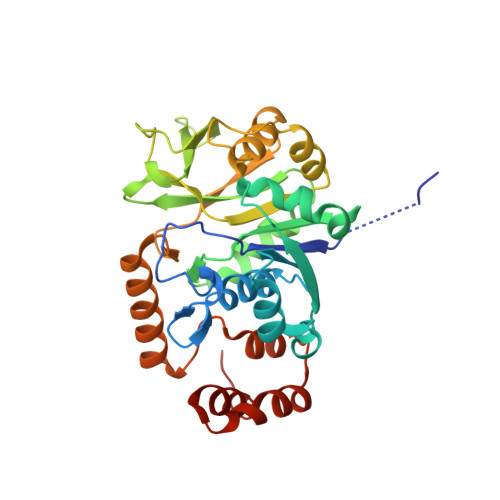Allosteric competitive inhibitors of the glucose-1-phosphate thymidylyltransferase (RmlA) from Pseudomonas aeruginosa.
Alphey, M.S., Pirrie, L., Torrie, L.S., Boulkeroua, W.A., Gardiner, M., Sarkar, A., Maringer, M., Oehlmann, W., Brenk, R., Scherman, M.S., McNeil, M., Rejzek, M., Field, R.A., Singh, M., Gray, D., Westwood, N.J., Naismith, J.H.(2013) ACS Chem Biol 8: 387-396
- PubMed: 23138692
- DOI: https://doi.org/10.1021/cb300426u
- Primary Citation of Related Structures:
3ZLK, 3ZLL, 4ARW, 4ASJ, 4ASY, 4B2W, 4B2X, 4B3U, 4B42, 4B4B, 4B4G, 4B4M, 4B5B - PubMed Abstract:
Glucose-1-phosphate thymidylyltransferase (RmlA) catalyzes the condensation of glucose-1-phosphate (G1P) with deoxy-thymidine triphosphate (dTTP) to yield dTDP-d-glucose and pyrophosphate. This is the first step in the l-rhamnose biosynthetic pathway. l-Rhamnose is an important component of the cell wall of many microorganisms, including Mycobacterium tuberculosis and Pseudomonas aeruginosa. Here we describe the first nanomolar inhibitors of P. aeruginosa RmlA. These thymine analogues were identified by high-throughput screening and subsequently optimized by a combination of protein crystallography, in silico screening, and synthetic chemistry. Some of the inhibitors show inhibitory activity against M. tuberculosis. The inhibitors do not bind at the active site of RmlA but bind at a second site remote from the active site. Despite this, the compounds act as competitive inhibitors of G1P but with high cooperativity. This novel behavior was probed by structural analysis, which suggests that the inhibitors work by preventing RmlA from undergoing the conformational change key to its ordered bi-bi mechanism.
- Biomedical Sciences Research Complex, University of St. Andrews , St. Andrews KY16 9ST, U.K.
Organizational Affiliation:



















